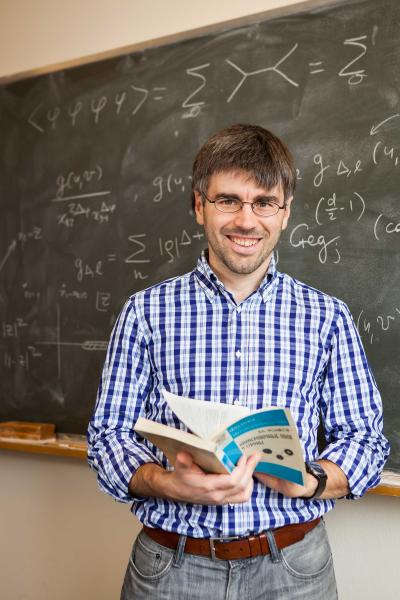CERN theorist Slava Rychkov got an unexpected phone call on the way home from the climbing gym last week. A member of Russian billionaire Yuri Milner's Fundamental Physics Prize committee called to inform Rychkov that he had won the $100,000 New Horizons prize for promising junior researchers in fundamental physics.
"It was totally unexpected," says Rychkov. "I'm always happy for colleagues when they get prizes, but of course that is not the reason we do research!"
Rychkov was born in Samara, Russia, some 1000km from Moscow. He studied mathematics at the Moscow Institute of Physics and Technology and later at Princeton, and first became interested in connecting mathematical questions to the real world during a postdoc in Amsterdam.
"But my second postdoc – at the Scuola Normale in Pisa, Italy, under Riccardo Barbieri – was a really formative experience," he says. "That's where I learnt which were the experimentally relevant questions."
For Rychkov, the experimentally relevant questions were part of a theory called electroweak symmetry breaking. At Pisa, he worked on scenarios such as Supersymmetry and Composite Higgs, which describe possible physics beyond the Standard Model. But it was for his work on conformal field theory – which Rychkov started during a month-long visit to the CERN Theory Unit in August 2006 – that he won the New Horizons prize.

"A few years earlier, the ideas of conformal field theory led to the formulation of Conformal Technicolor – a highly efficient model of electroweak symmetry breaking," says Rychkov. "With Supersymmetry you have to add lots of particles to the Standard Model to make the equations work. But conformal field theory works well with minimal modification to the Standard Model – just the part that describes the Higgs at high energies. You can solve the hierarchy problem, but at the same time you don't destroy how the Model describes everything else. In this scenario you could have it both ways!"
Though it later turned out that Conformal Technicolor is impossible, the analytical and numerical techniques that Rychkov and others developed to rule out this scenario are arguably the most important part of his research. "It became clear that the method we developed could be applied to other physical situations which don't have to do with electroweak symmetry breaking," he says.
This method, "conformal bootstrap" was first proposed in the 1970s but lay mostly dormant apart from some exceptional cases. Rychkov and others have reinvigorated this area of physics with a new approach. "We have shown that there are equations there that we have to take seriously. We don't have to keep conformal bootstrap on life-support any more," he says. "The field has now acquired a life of its own, and I'm thinking about the next direction to go."
Also honoured with New Horizons prizes this year are physicists Freddy Cachazo of the Perimeter Institute in Ontario, Canada, and Shiraz Naval Minwalla of the Tata Institute of Fundamental Research in Mumbai, India.
